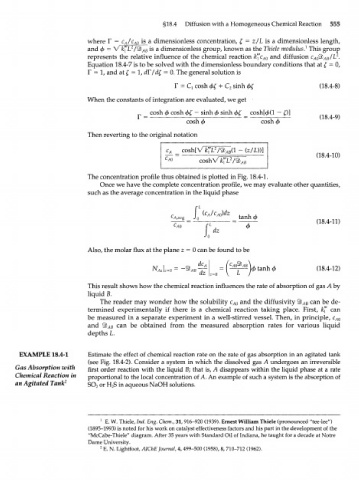Page 575 - Bird R.B. Transport phenomena
P. 575
§18.4 Diffusion with a Homogeneous Chemical Reaction 555
where Г = c /c A0 is a dimensionless concentration, £ = z/L is a dimensionless length,
A
2
and ф = V k"'L /ЯЬ is a dimensionless group, known as the Thiele modulus} This group
АВ
2
represents the relative influence of the chemical reaction k'"c A0 and diffusion с ЯЬ /Ь .
АВ
А0
Equation 18.4-7 is to be solved with the dimensionless boundary conditions that at f = 0,
Г = 1, and at £ = 1, dI7d£ = 0. The general solution is
Г = C] cosh Ф1 + C 2 sinh ф£ (18.4-8)
When the constants of integration are evaluated, we get
cosh ф cosh ФС - sinh ф sinh ф£ cosh[0(l -
(18.4-9)
Then reverting to the original notation
2
С А _ cosh[V k'"L /Q) (1 -- (z/L))] (18.4-10)
AB
C A0 coshVk'lV /aAB
The concentration profile thus obtained is plotted in Fig. 18.4-1.
Once we have the complete concentration profile, we may evaluate other quantities,
such as the average concentration in the liquid phase
A,avg I {CA/ /c )dz
C A0 tanh ф
J о (18.4-11)
C
A0 Ф
dz
Also, the molar flux at the plane z = 0 can be found to be
N \ - - Э ^ (18.4-12)
This result shows how the chemical reaction influences the rate of absorption of gas A by
liquid B.
The reader may wonder how the solubility c A0 and the diffusivity ЯЬ can be de-
АВ
termined experimentally if there is a chemical reaction taking place. First, k'" can
be measured in a separate experiment in a well-stirred vessel. Then, in principle, c A0
and ЯЬ can be obtained from the measured absorption rates for various liquid
АВ
depths L.
EXAMPLE 18.4-1 Estimate the effect of chemical reaction rate on the rate of gas absorption in an agitated tank
(see Fig. 18.4-2). Consider a system in which the dissolved gas A undergoes an irreversible
Gas Absorption with first order reaction with the liquid B; that is, A disappears within the liquid phase at a rate
Chemical Reaction in proportional to the local concentration of A. An example of such a system is the absorption of
an Agitated Tank 2 SO or H S in aqueous NaOH solutions.
2 2
1 E. W. Thiele, Ind. Eng. Chem., 31, 916-920 (1939). Ernest William Thiele (pronounced "tee-lee")
(1895-1993) is noted for his work on catalyst effectiveness factors and his part in the development of the
"McCabe-Thiele" diagram. After 35 years with Standard Oil of Indiana, he taught for a decade at Notre
Dame University.
2 E. N. Lightfoot, AIChE Journal, 4,499-500 (1958), 8, 710-712 (1962).

